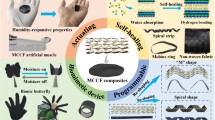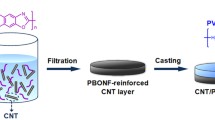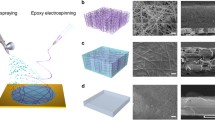Abstract
As a new type of smart device, soft actuators have received great attention due to their simple structure, fast response, and widely using. But so far, most of the soft actuators are driven by a single stimulus. Also, soft actuators with only a function of actuation can no longer meet the demands of versatile applications. Hence, a multi-functional and integrated actuator based on the composites of polyaniline@carbon nanotube–cellulose nanofiber (PANI@CNT–CNF) is proposed. As served as a component of soft actuators, the PANI@CNT–CNF/polymer actuator can respond to humidity and light with rapid and repeatable bending motions. The PANI@CNT–CNF/polymer actuator can be applied in biomimetic applications, such as humidity-driven flowers, and light-driven worms. Further, an integrated actuator that can simultaneously use the functions of actuation and energy storage is designed and proposed. The integrated actuator can be driven by near-infrared light with a maximum bending angle of 45°. Besides that, the capacitance of the integrated actuator is 39.8 mF demonstrating the ability of energy storage. Finally, the integrated actuator is applied to simultaneously bend and power light-emitting diode lights, showing the advance of the integrated actuator. We believe that the integrated actuators with a function of energy storage can be applied to various complex environments and have prospects for applications in smart devices.
Graphical abstract







Similar content being viewed by others
Data availability
Data will be made available on request.
References
Akbarzadeh S, Ramezanzadeh M, Ramezanzadeh B, Mahdavian M, Naderi R (2019) Fabrication of highly effective polyaniline grafted carbon nanotubes to induce active protective functioning in a silane coating. Ind Eng Chem Res 58:20309–20322. https://doi.org/10.1021/acs.iecr.9b04217
Almeida DAL, Edwards ER, Ferreira NG (2018) Self-sustaining hybrid electrode prepared from polyaniline, carbon nanotubes, and carbon fibers: morphological, structural, and electrochemical analyses. J Solid State Electr 22:69–80. https://doi.org/10.1007/s10008-017-3722-0
Bavio MA, Acosta GG, Kessler T (2014) Synthesis and characterization of polyaniline and polyaniline–carbon nanotubes nanostructures for electrochemical supercapacitors. J Power Sources 245:475–481. https://doi.org/10.1016/j.jpowsour.2013.06.119
Bhuyan P et al (2021) Soft and stretchable liquid metal composites with shape memory and healable conductivity. ACS Appl Mater Interface 13:28916–28924. https://doi.org/10.1021/acsami.1c06786
Bisoyi HK, Li Q (2022) Liquid crystals: versatile self-organized smart soft materials. Chem Rev 122:4887–4926. https://doi.org/10.1021/acs.chemrev.1c00761
Bleda-Martínez MJ, Morallón E, Cazorla-Amorós D (2007) Polyaniline/porous carbon electrodes by chemical polymerisation: effect of carbon surface chemistry. Electrochim Acta 52:4962–4968. https://doi.org/10.1016/j.electacta.2007.01.073
Bokobza L, Zhang J (2012) Raman spectroscopic characterization of multiwall carbon nanotubes and of composites. Express Polym Lett 6:601–608. https://doi.org/10.3144/expresspolymlett.2012.63
Chen N et al (2022) Conductive photo-thermal responsive bifunctional hydrogel system with self-actuating and self-monitoring abilities. Nano Res 15:7703–7712. https://doi.org/10.1007/s12274-022-4394-3
Chen L, Weng M, Zhou P, Zhang L, Huang Z, Zhang W (2017) Multi-responsive actuators based on a graphene oxide composite: intelligent robot and bioinspired applications. Nanoscale 9:9825–9833. https://doi.org/10.1039/C7NR01913K
Elnaggar EM, Kabel KI, Farag AA, Al-Gamal AG (2017) Comparative study on doping of polyaniline with graphene and multi-walled carbon nanotubes. J Nanostruct Chem 7:75–83. https://doi.org/10.1007/s40097-017-0217-6
French AD (2014) Idealized powder diffraction patterns for cellulose polymorphs. Cellulose 21:885–896. https://doi.org/10.1007/s10570-013-0030-4
Fu L, Zhao W, Ma J, Yang M, Liu X, Zhang L, Chen Y (2022) A humidity-powered soft robot with fast rolling locomotion. Research 2022:9832901. https://doi.org/10.34133/2022/9832901
Fukuzumi H, Saito T, Iwata T, Kumamoto Y, Isogai A (2009) Transparent and high gas barrier films of cellulose nanofibers prepared by tempo-mediated oxidation. Biomacromolecules 10:162–165. https://doi.org/10.1021/bm801065u
Ge W et al (2022) Highly tough, stretchable, and solvent-resistant cellulose nanocrystal photonic films for mechanochromism and actuator properties. Small 18:2107105. https://doi.org/10.1002/smll.202107105
Ghosh R, Misra A (2021) Carbon nanotube-based hierarchical paper structure for ultra-high electrothermal actuation in a wide humidity range. ACS Appl Electron Mater 3:1260–1267. https://doi.org/10.1021/acsaelm.0c01069
Ji Y, Xing Y, Li X, Shao L (2019) Dual-stimuli responsive carbon nanotube sponge-PDMS amphibious actuator. Nanomaterials 9:1704. https://doi.org/10.3390/nano9121704
Jin X, Shi Y, Yuan Z, Huo X, Wu Z, Wang ZL (2022) Bio-inspired soft actuator with contact feedback based on photothermal effect and triboelectric nanogenerator. Nano Energy 99:107366. https://doi.org/10.1016/j.nanoen.2022.107366
Liu Z, Li B, Liu YD, Liang Y (2022) Integrated bending actuation and the self-sensing capability of poly(vinyl chloride) gels with ionic liquids. Adv Funct Mater 32:2204259. https://doi.org/10.1002/adfm.202204259
Lu Q, Wang X (2022) Recent progress of sub-nanometric materials in photothermal energy conversion. Adv Sci 9:2104225. https://doi.org/10.1002/advs.202104225
Mariano LC, Salvatierra RV, Cava CE, Koehler M, Zarbin AJG, Roman LS (2014) Electrical properties of self-assembled films of polyaniline/carbon nanotubes composites. J Phys Chem C 118:24811–24818. https://doi.org/10.1021/jp502650u
Meng C, Liu C, Fan S (2009) Flexible carbon nanotube/polyaniline paper-like films and their enhanced electrochemical properties. Electrochem Commun 11:186–189. https://doi.org/10.1016/j.elecom.2008.11.005
Nguyen DC, Bui TT, Hua SH, Chun H, Kim YS (2022) New stand-alone hygrometers based on the moisture-driven bending of a nanoclay and polyimide bilayer. Sens Actuator B Chem 359:131559. https://doi.org/10.1016/j.snb.2022.131559
Ni X, Guo X, Li J, Huang Y, Zhang Y, Rogers JA (2019) 2d mechanical metamaterials with widely tunable unusual modes of thermal expansion. Adv Mater 31:1905405. https://doi.org/10.1002/adma.201905405
Peng L et al (2022) Slug-inspired magnetic soft millirobot fully integrated with triboelectric nanogenerator for on-board sensing and self‐powered charging. Nano Energy 99:107367. https://doi.org/10.1016/j.nanoen.2022.107367
Uchida J, Soberats B, Gupta M, Kato T (2022) Advanced functional liquid crystals. Adv Mater 34:2109063. https://doi.org/10.1002/adma.202109063
Wang M et al (2022) Ultrafast response and programmable locomotion of liquid/vapor/light-driven soft multifunctional actuators. ACS Nano 16:2672–2681. https://doi.org/10.1021/acsnano.1c09477
Wang X, Tan CF, Chan KH, Lu X, Zhu L, Kim S, Ho GW (2018) In-built thermo-mechanical cooperative feedback mechanism for self-propelled multimodal locomotion and electricity generation. Nat Commun 9:3438. https://doi.org/10.1038/s41467-018-06011-9
Wang H, Zhao Z, Liu P, Pan Y, Guo X (2022) Stretchable sensors and electro-thermal actuators with self-sensing capability using the laser-induced graphene technology. ACS Appl Mater Interface 14:41283–41295. https://doi.org/10.1021/acsami.2c09973
Weng M, Duan Y, Zhou P, Huang F, Zhang W, Chen L (2020) Electric-fish-inspired actuator with integrated energy-storage function. Nano Energy 68:104365. https://doi.org/10.1016/j.nanoen.2019.104365
Weng M, Xiao Y, Yao L, Zhang W, Zhou P, Chen L (2020) Programmable and self-healing light-driven actuators through synergetic use of water-shaping and -welding methods. ACS Appl Mater Interface 12:55125–55133. https://doi.org/10.1021/acsami.0c14380
Wu T, Lin Y (2006) Doped polyaniline/multi-walled carbon nanotube composites: preparation, characterization and properties. Polymer 47:3576–3582. https://doi.org/10.1016/j.polymer.2006.03.060
Wu T, Lin Y, Liao C (2005) Preparation and characterization of polyaniline/multi-walled carbon nanotube composites. Carbon 43:734–740. https://doi.org/10.1016/j.carbon.2004.10.043
Xu L et al (2022) An insect larvae inspired mxene-based jumping actuator with controllable motion powered by light. Nano Energy 103:107848. https://doi.org/10.1016/j.nanoen.2022.107848
Yan X, Tai Z, Chen J, Xue Q (2011) Fabrication of carbon nanofiber-polyaniline composite flexible paper for supercapacitor. Nanoscale 3:212–216. https://doi.org/10.1039/c0nr00470g
Zhan X et al (2021) Mechanically strong double-layered aramid nanofibers/mwcnts/pani film electrode for flexible supercapacitor. J Electrochem Soc 168:20513. https://doi.org/10.1149/1945-7111/abdef0
Zhang X et al (2014) Photoactuators and motors based on carbon nanotubes with selective chirality distributions. Nat Commun 5:3983. https://doi.org/10.1038/ncomms3983
Zhang X et al (2021) Soft robotic reinforced by carbon fiber skeleton with large deformation and enhanced blocking forces. Compos Part B Eng 223:109099. https://doi.org/10.1016/j.compositesb.2021.109099
Zhou P, Chen L, Yao L, Weng M, Zhang W (2018) Humidity- and light-driven actuators based on carbon nanotube-coated paper and polymer composite. Nanoscale 10:8422–8427. https://doi.org/10.1039/c7nr09580e
Acknowledgments
Thanks for the support provided by the National Natural Science Foundation of China, Natural Science Foundation of Fujian Province, College Students Innovation and Entrepreneurship Training Program of China, and Fujian University of Technology.
Funding
This work was supported by the National Natural Science Foundation of China [Grant Number 52103138], Natural Science Foundation of Fujian Province [Grant Number 2020J05188], College Students Innovation and Entrepreneurship Training Program of China [Grant No. 202210388009], and Starting Research Fund from Fujian University of Technology [GY-Z19083, GY-Z220199].
Author information
Authors and Affiliations
Contributions
YY and YZ contributed equally. All authors contributed to the study conception and design. Material preparation, data collection and analysis were performed by YY, and YZ. The first draft of the manuscript was written by YY, and MW. The manuscript was revised by YY, and PZ. All authors commented on previous versions of the manuscript. All authors read and approved the final manuscript.
Corresponding authors
Ethics declarations
Conflict of interest
The authors declare no conflict of interest.
Ethics approval and consent to participate
Not applicable.
Consent for publication
Not applicable.
Additional information
Publisher’s Note
Springer Nature remains neutral with regard to jurisdictional claims in published maps and institutional affiliations.
Electronic supplementary material
Below is the link to the electronic supplementary material.
Supplementary Material 2
Rights and permissions
Springer Nature or its licensor (e.g. a society or other partner) holds exclusive rights to this article under a publishing agreement with the author(s) or other rightsholder(s); author self-archiving of the accepted manuscript version of this article is solely governed by the terms of such publishing agreement and applicable law.
About this article
Cite this article
Ye, Y., Zhu, Y., Zhou, P. et al. Multi-functional and integrated actuator based on carbon nanotube–cellulose nanofiber composites. Cellulose 30, 7221–7234 (2023). https://doi.org/10.1007/s10570-023-05329-y
Received:
Accepted:
Published:
Issue Date:
DOI: https://doi.org/10.1007/s10570-023-05329-y




